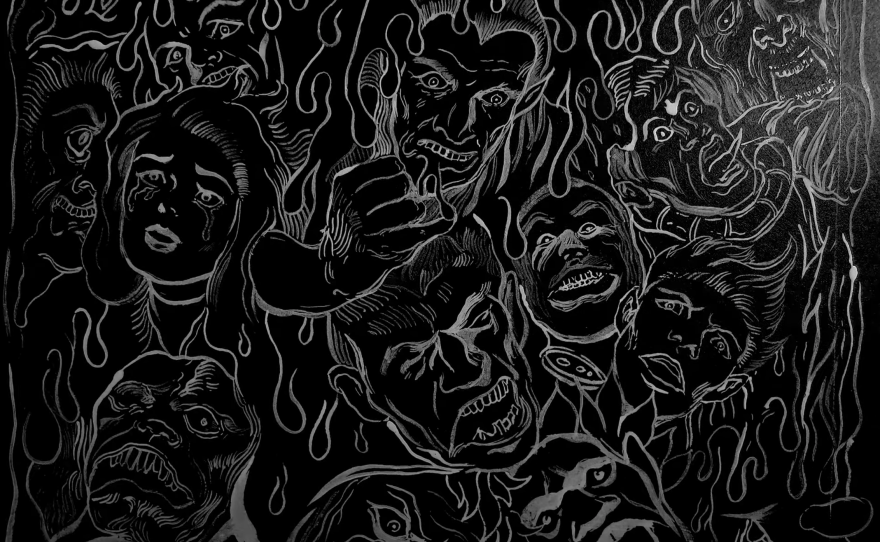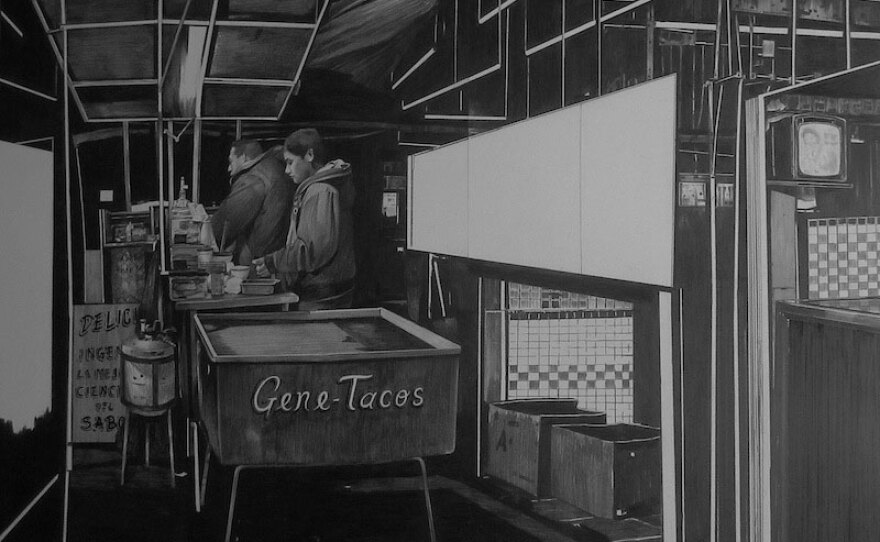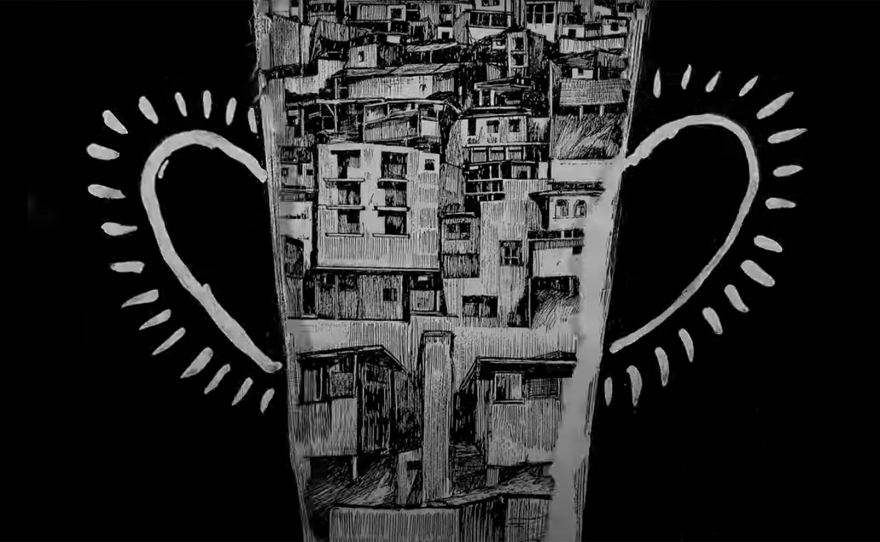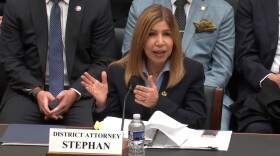As a child, artist Hugo Crosthwaite spent a lot of time hanging out in his father's curio shop in Rosarito, Mexico. It was there that the seeds were planted for his particular approach to art.
"That's where I learned English, by just interacting with American tourists," Crosthwaite said. "I would tell them stories about a little ceramic idol and I would make up stories about 'Oh, this is Tlaloc, the god of rain.' It wasn't."
While he wasn't the best salesperson, the storytelling struck a chord with Crosthwaite. He also spent long stretches of time in the shop with nothing to do except doodle and draw.
For the winner of the 2019 Smithsonian National Portrait Gallery competition and 2021 San Diego Art Prize recipient, becoming an artist was not something on his radar, despite his penchant for drawing.
"I never thought about becoming an artist. I never had any idea of art. I never went to art museums," Crosthwaite said.
Eventually, Crosthwaite studied graphic design at Southwestern College, then at San Diego State University, but his heart wasn't in it. A guidance counselor advised him to take a semester of art history instead, studying artists, visiting the San Diego Museum of Art and the Museum of Contemporary Art San Diego and writing about pieces of art.
"That class changed my life," Crosthwaite said.
A detail he still remembers from that art history class is the textbook, full of monochrome photographs of fine artworks. He was struck by the richness of stories in the original works, as well as in the particular way he experienced them, in black and white.
"I thought, this is what I want to do. I want to tell stories. Not necessarily be a painter but just be able to tell stories through drawing," Crosthwaite said.
Then, when he saw an exhibition of works by the Norwegian painter Odd Nerdrum, he fell in love with the bold imagery and dramatic characters in Nerdrum's larger-than-life paintings.

A Tijuana artist
Through his childhood, and even into young adulthood in the 1990s, Crosthwaite said being a cross-border person was simpler than it is today. He lived in Tijuana while attending San Diego State, and his mother even crossed the border to do her laundry in San Diego.
Even then, he didn't necessarily consider his art to be particularly cross-border or rooted in the region — until he moved away.
Living first in Atlanta, then in New York, Crosthwaite recognized his origins, as well as the way he was perceived by others. Stereotypes about Tijuana painted a specific tourist lifestyle. Or, upon hearing he was a Mexican artist, people expected his work to be rich with colors, like that of Frida Kahlo.
"I started questioning where I come from, something that I had never questioned before, and I started to see myself, well, yes, I'm a Mexican artist, but I'm also a Tijuana artist," Crosthwaite said. "So then I started playing with this notion of identity and my identity as a border artist, and then also playing with this folklore about Mexico, about what they think Mexican identity is."
When he returned from New York, he focused his practice on art that is specifically about Tijuana, and would sit in parks or at intersections with a sketchbook, capturing the life in the city in the form of faces, or even fonts and lettering at taco stands.

The classical roots in Crosthwaite's work are significant, though his style is distinctly new — combining improvisation, myth, fine detail and pop elements.
His works often involve stop-motion animation, a series of snapshots of the process of the drawing. With these works, he challenges the idea that drawing needs to be static.
The story unfolds in the choices he makes as he draws — the way body parts, expressions or backgrounds happen to the characters becomes akin to a plot. Sometimes, faces or other details are erased after the drawing seems to be complete.
In 2019, Crosthwaite was diagnosed with cancer. His work was suddenly limited — no big murals, no busy activity.
"My whole life just got reduced to my little sketchbook," Crosthwaite said.
By the time his treatment finished, the pandemic set in, which kept him home even longer. Crosthwaite continued his stop-motion model during the pandemic.
With a sketchbook and his camera, he recorded 40 individual "Dibujos de Cuarentena," or quarantine drawings — again, all in black and white, and he posted some of the mesmerising videos on his Instagram account.
A story in music
The storytelling in these stop-motion videos is one of the things that caught Phil Beaumont's attention.
Beaumont, a musician and member of the San Diego band The Color Forty Nine, recently worked with Mexican musician Rubén Albarrán (of Café Tacvba) on a forthcoming single, "What Would I Know? / ¿Yo Que Sé?" Crosthwaite, Beaumont thought, would be a dream collaborator.
RELATED: Moved By Music: Phil Beaumont Of The Color Forty Nine
"The Dibujos de Cuarentena, I was watching those as well," Beaumont said. He also was struck by Crosthwaite's work in the National Portrait Gallery for his stop-motion portrait of a migrant, Berenice Sariento Chávez. "Oh my goodness, thinking, could he do this?"
To tell the song's story in a video, Crosthwaite used a small handheld camera, taking approximately 700 photos per drawing, Beaumont said. The powerful video includes imagery of the border, Tijuana, love, folklore, monsters and more.
The Color Forty-Nine will premiere the music video Friday, July 23 during a live performance and EP release at The Casbah.
Beaumont said that he thinks Crosthwaite's work is bigger than just one song, and they'll be exploring other options for the collaboration — including a possible series of clips on a digital billboard at the border, as well as cross-border broadcasts of performances.
"When we got the song, I wanted to honor the song and get a really good video," Beaumont said. "Then we got this amazing video. So, how do I honor Hugo's work in this? I'm so tired of how things just disappear on Instagram and all that stuff, so I'm trying to be a little bit more inventive."
Crosthwaite's artwork can also be seen at San Diego Art Institute, as part of the SD Practice exhibition, and his 2018 large-scale, improvisational outdoor murals can be found at Liberty Station.

For the San Diego Art Prize, Crosthwaite will present new works in a special exhibition this October at Bread and Salt, alongside the three other winners: Beliz Iristay, Perry Vasquez and PANCA.
As for that origin story in his father's Rosarito curio shop, it continued to play into his artistic journey — albeit as a background role.
"My father always said, 'You know, whatever happens, you could always come back home and open a curio shop,'" Crosthwaite said, and that as he inched towards a career as an artist, this refrain gave him both the go-ahead and a reminder of home.






